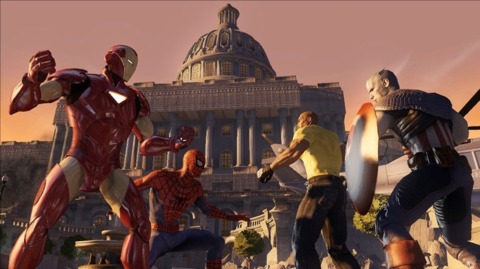Marvel: Ultimate Alliance 2 writers tell tales
GDC Austin 2009: Activision's latest was based on the existing Civil War storyline, but Vicarious Visions' writers still had plenty of work to do.
Who Was There: Vicarious Visions' Evan Skolnick and Jonathan Mintz, respectively, the lead writer and narrative designer on Marvel: Ultimate Alliance 2

What They Talked About: Skolnick kicked the session off by explaining the differences among various types of writers. He likened the short story writer to a sprinter, the novelist to a marathon runner, and the movie writer to a relay runner. As for the game writer? That's more like riding a bull. As he put it, the game wants to be a game, and the writer just tries to hang on.
Mintz underscored the scope of the writing assignment for Marvel: Ultimate Alliance 2, which condensed the year-long Marvel Comics Civil War crossover into a game with 15,000 lines of dialogue (8,000 of them provided in voice-over) and 55 minutes of cutscenes.
Although the story was based on Civil War, Sklonick said the team started by looking at what worked well in the original Marvel: Ultimate Alliance. The writer said the epic scope of the tale in the original extended the play time, and there was plenty of fan service at every turn, with a wide variety of characters and details pulled from the Marvel universe.
For Ultimate Alliance 2, Mintz said the focus was on bringing the tone of the project up to date with what was going on in Marvel Comics. That meant the story had to have shades of gray, as the Civil War storyline had heroes divided over a political issue of superhero registration with arguments to be made on both sides. Other focal points were to use a more grounded world with more realistic dialogue.
The writing was a significant challenge for the game, as Mintz noted that players could create their own teams from the game's roster and make those characters come down on either side of the argument. That meant dialogue needed to be created for every character in the game. And because players could choose to come down on either side of the superhero registration debate, the writers needed dialogue that sounded natural for every character regardless of which stance the players had picked.
As if the Civil War storyline wasn't large enough in scale, Mintz and Skolnick said they decided to include a previous Marvel crossover, Secret War, as essentially an introductory act to the game. As Mintz explained, that helped transition players of the first Marvel Ultimate Alliance from the black-and-white, good-versus-evil tone of the original game (and superhero comics in general) to the more conflicted version of Civil War.
The development team also needed to make compromises when adapting the story for the sake of gameplay. For one, Hulk and Thor play major roles in the game, though they spent the Civil War series on the sidelines. Another problem came up with the decision to build the game from scratch. That meant the developers wouldn't have time to create as large a roster of heroes and villains as they wanted. Fortunately, the storyline of the game allowed them to use and reuse characters as both allies and enemies as heroes switch allegiances throughout the story.
Skolnick went back to the goal of making the characters sound like themselves when they talk. The developers eventually organized player characters into about eight different personality types, with an aggressive, defensive, and passive option for each dialogue tree. Characters with a particularly unique flavor to their dialogue, like Hulk, may have been the only character to use that, and non-player characters' responses were tailored to work with each of the attitudes, rather than the characters addressing them or the specific lines being delivered.
The task was further complicated by having to integrate the writing process with the rest of the game's development. For example, Skolnick and Mintz had to work with the game's mission designer at every step of the way to see what was needed in terms of voice-over and then constantly revisit that as the developers changed and refined the mission's gameplay. The pair even had to do a bit of bug testing, playing through the game to check problems that ordinary QA might miss, like Wolverine being given the "realist" dialogue options instead of the "renegade" ones.
Quote: "That was a dark moment."--Skolnick, talking about having the producer of the game and company CEO wearing masks of Iron Man and other game characters for a table reading of the script.
Takeaway: Skolnick and Mintz' session was as much about the logistics of having a lead writer and a narrative designer onsite with the development team as it was about the challenges of writing Marvel: Ultimate Alliance 2. While the pair said the model ultimately worked, they underscored the need to have the writing team incorporated and in communication with the development team at every step of the process.
Got a news tip or want to contact us directly? Email news@gamespot.com
Join the conversation